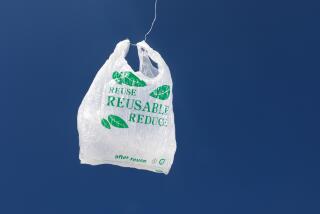Detergent Scores a Clean Sweep in Marketing : Trends: Manufacturers are finding ways to counter environmental concerns over the popular soap substitute.
- Share via
Laundry detergents entered the American home 60 years ago. Before that, soaps prevailed.
The difference between the two is considerable. Soaps, which go back to antiquity, consist mostly of animal or vegetable oils that work with water to remove dirt from fabrics, provided the water is warm, soft and non-acidic and is agitated throughout the process. As long as fats and oils were plentiful, soaps could do the job of keeping clothes clean.
During World War I, however, Germany ran low on soap’s raw materials, which were largely imported, and the shortage encouraged chemists to come up with synthetic substitutes called detergents. Made up of non-fat materials, the substitutes seemed to work well even in the hard-water areas that dominated the country.
Additional research in the peacetime decade of the 1920s led to widespread German production of a brand-name detergent, Gardinol, in 1930. The product reached American shores two years later.
Since the new detergent cleaned clothes well, eliminating the hard-water scum that sometimes, with inadequate rinsing, was retained in the fabrics, it induced American manufacturers to get on the non-soap bandwagon.
Procter & Gamble was the first firm to copy Gardinol. It test-marketed Dreft detergent in hard-water towns in Ohio in 1933, boasting that its suds-making ability was unsurpassed by any soap. But the product was expensive, and by November, 1940, combined brands of detergents, according to Fortune magazine, occupied only a tiny space on the laundry shelf: 100 million pounds a year compared to 2.8 billion pounds of soaps.
Fortune concluded that the detergents “excite chemists more than they do housewives now, but they may mean a quiet revolution in the soap business.”
The revolution came during World War II. The industry took advantage of technology in the burgeoning petroleum field to find new ingredients to replace the relatively costly alcohol sulfates as the basis for detergents.
Specifically, the production of aviation fuel provided knowledge of byproducts that contributed to the development of washing powders using ABS (alkyl benzene sulfonate), which provided excellent cleansing at a price competitive with soaps. Also available after World War II was sodium tripolyphospate, a powerful remover of dirt from clothes.
In 1946 more Americans said goodby to soaps and hello to Procter & Gamble’s Tide. A year later, Lever Bros. introduced Breeze, and Colgate Palmolive came up with Fab in 1948.
But many consumers were wary. And manufacturers of washing machines weren’t about to side with the new detergents, as illustrated by a Frigidaire ad in Life magazine on July 30, 1950, which opted for both cleaners: “Automatically,” read the blurb, this machine “makes good soap or detergent even more effective.”
Continued refinement of detergent’s superior cleansing power under most washing conditions gave it the lead among laundry agents by 1953. Not that the housewife cared much about the specific difference between soaps and detergents in terms of chemical properties. The litmus test, in Fortune’s words, was whether “the pillowcases are white.” On that score card, detergents could claim unconditional victory by 1960.
But the victory was not without problems. The sudsy detergents created so much foaming that sewage-treatment plants had difficulty managing proper filtering of disposed materials. Muddying the situation was disagreement between detergent firms and public officials over the specific cause of the foamy layers in treatment areas, sometimes several feet high.
Then there was debate on the likelihood of detergents’ adverse effect on aquatic organisms and household water supplies because their failure to decompose might lead to health and environmental problems.
Hence, two new words surfaced among some scientists and environmentalists: the biological degradation of detergents, later contracted to biodegradable.
By the mid-1960s the industry had developed a substitute for ABS, namely LAS (linear alkyl sulfonate), that significantly increased the biodegradability of detergents and reduced the need for phosphates, which some states had begun to ban because their inducement of algae blooms on rivers and streams threatened oxygen supplies for fish.
In addition, the industry in recent years has developed highly concentrated products that do more cleaning per scoop, not cup, which also reduces the amount of packaging that contributes to the trash crisis. And the movement toward liquid detergents has been intense, starting with Procter & Gamble’s announcement of liquid Tide at a formal news conference in 1984.
But some things haven’t changed from the pre-detergent years, especially old language. The afternoon TV serials, often sponsored by detergent companies, are still called soaps.
More to Read
Inside the business of entertainment
The Wide Shot brings you news, analysis and insights on everything from streaming wars to production — and what it all means for the future.
You may occasionally receive promotional content from the Los Angeles Times.










